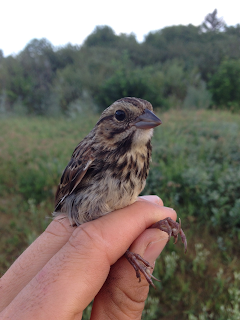We are now 2/3's of the way done the 6th season of Wascana MAPS! Does the summer fly by or what!?
Our most exciting find was recapturing our oldest known bird to date at Wascana MAPS. This female American Robin who we first banded on June 26, 2010 proved she was still alive by getting caught in one of our nets! When I first banded this bird in 2010, she was an ASY bird, meaning she was hatched in 2008 or earlier! So she is 7 years old now or older! Wow! This is the 4th time in 6 years we have seen her, first in 2010, again in 2012, 2014 and now 2015.
This bird demonstrates why banding birds with unique identifiers is so important to understanding population dynamics. When I have a bird in my hand, I can typically tell whether that bird hatched this year, last year or sometime before that (for many songbird species). But if that bird is 7 years old like this robin, without a band on her leg, I could only say she is 2 years old or maybe more...
Truly amazing when you consider an ADULT robin only has about a 50% chance of surviving each year (based on MAPS results for our region). So in 2009 if we band 100 robins (the year she would be considered an adult), by 2010, only 50 will be alive. By 2011, 25 are left, 2012, 12 are left, by 2013, 6 are left, and by 2014 maybe 3 are left. By 2015, in theory only 1 or maybe 2 of those robins banded 7 years ago should be alive... I'll say it again. WOW!
Female American Robin (#922-79913) first banded in 2010.
We also recaptured a Brown-headed Cowbird (2013), a Gray Catbird (2011), a Common Yellowthroat (2012) and a Song Sparrow (2013), who have been recaptured EVERY year since they were first banded (in brackets). These birds are demonstrating how important Wascana Marsh is for their survival and how strong their fidelity is to this location. These birds travel thousands of kilometers away each fall and back in the spring, to come back specifically to this area in Wascana Park! Truly amazing stuff and truly speaks to why protecting this area for these animals is so important.
Female Brown-headed Cowbird (# 2571-03960) first banded in 2013 and recaptured at Wascana MAPS each year since.
We have now completed what is termed the Adult superperiod in MAPS jargon. Sessions 1-4 are dominated by breeding adults and few young (although we have seen a lot of young American Robins and Song Sparrows in the last 2 sessions). For the last two session of the summer we enter the Young superperiod! This is when we see a lot of the young that were produced during the summer start to really disperse (as they are heading out on their own) and start to arrive in our nets. Last year (2014) because of a number of factors we saw a pretty significant decrease in the number of young produced compared to the previous 3 years.
So far this year we have seen the highest number of young Song Sparrows every banded at Wascana MAPS, which is 15 birds! Prior to this, the highest number we have captured in a summer is 3! This is great to see, as last year only 1 young Song Sparrow was captured.
One of the 15 juvenile Song Sparrows we have captured this year at Wascana MAPS.
Here are our total results so far for 2015.
In addition, here is a comparison graph of the total number of birds captured during each session at Wascana MAPS from 2010 to 2015.





No comments:
Post a Comment